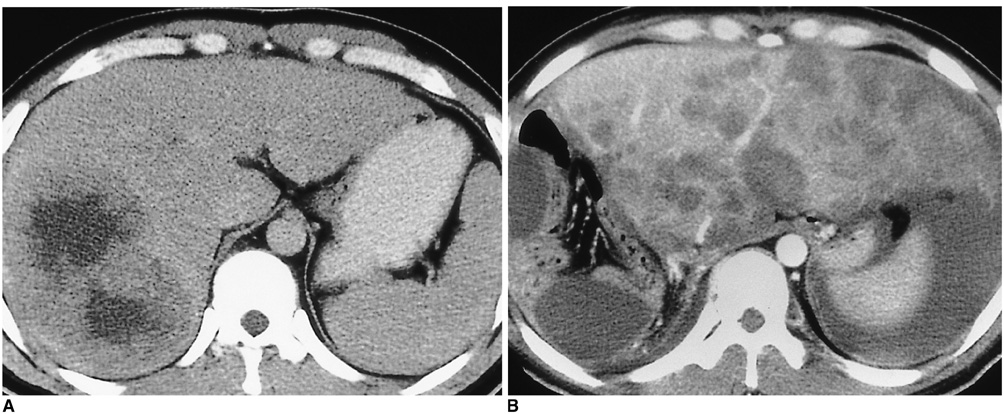Korean J Radiol.
2000 Mar;1(1):38-42. 10.3348/kjr.2000.1.1.38.
Early Recurring Hepato cellular Carcinoma after Partial Hepatic Resection: Preoperative CT Findings
- Affiliations
-
- 1Department of Radiology, Samsung Medical Center, Sungkyunkwan University School of Medicine, Seoul, Korea. jhlim@smc.samsung.co.kr
- KMID: 1777294
- DOI: http://doi.org/10.3348/kjr.2000.1.1.38
Abstract
OBJECTIVE
The purpose of this study was to determine the utility of preoperative CT in predicting early recurrence of hepatocellular carcinoma after partial hepatic resection. MATERIALS AND METHODS: Preoperative three-phase helical CT scans in 53 patients with hepatocellular carcinoma were retrospectively reviewed by two radiologists. In 27 patients (group I), HCC had recurred within six months, while 26 (group II) had remained disease free for at least two years. In each group, preoperative CT findings were evaluated in each group for the tumor size and number, the presence or absence of capsule, distinctness of tumor margin, perinodular extension, and the presence or absence of portal vein thrombosis. RESULTS: In group I, a tumor capsule of tumor was seen in five of 27 patients (19%), and in group II, in 16 of 26 (62%) (p = .001). The tumor margin was distinct in eight patients (30%) in group I and in 20 (77%) in group II (p = .001). Multiple tumors, perinodular extension, and portal vein thrombosis were more frequently seen in group I but the differences were not statistically significant (p > .05). Tumor size was similar in each group (p > .05). CONCLUSION: Preoperative CT findings that may help predict the early recurrence of hepatocellular carcinoma after surgical resection are an absence of capsule of tumors and an indistinct margin. Reference to these findings during preop-erative CT can guide clinicians in their choice of treatment.
MeSH Terms
Figure
Cited by 1 articles
-
Preoperative Radiologic and Postoperative Pathologic Risk Factors for Early Intra-Hepatic Recurrence in Hepatocellular Carcinoma Patients Who Underwent Curative Resection
Honsoul Kim, Mi-Suk Park, Young Nyun Park, Hyunki Kim, Kyung Sik Kim, Jin Sub Choi, Sang Hoon Ahn, Kwang-Hyub Han, Myeong-Jin Kim, Ki Whang Kim
Yonsei Med J. 2009;50(6):789-795. doi: 10.3349/ymj.2009.50.6.789.
Reference
-
1. Kanematsu T, Takenaka K, Matsumata T, Furuta T, Sugimachi K, Inokuchi K. Limited hepatic resection effective for selected cirrhotic patients with primary liver cancer. Ann Surg. 1984. 199:51–56.2. Izumi R, Shimizu K, Ii T, et al. Prognostic factors of hepatocellular carcinoma in patients undergoing hepatic resection. Gastroenterology. 1994. 106:720–727.3. Yamamoto M, Matsuda M, Iimuro Y, Fuji H, Nagahori K, Ainota K. Intrahepatic distant metastasis and metachronous multicentric occurrence in solitary hepatocellular carcinoma of less than five centimeters in diameter. Surg Today. 1993. 23:969–978.4. Nagao T, Inoue S, Yochimi F, et al. Postoperative recurrence of hepatocellular carcinoma. Ann Surg. 1989. 211:28–33.5. Chen M-F, Whang T-L, Jeng L-B, Wang C-S, Jan Y-Y, Chen S-C. Postoperative recurrence of hepatocellular carcinoma: two hundred five consecutive patients who underwent hepatic resection in 15 years. Arch Surg. 1994. 129:738–742.6. Belghiti J, Panis Y, Farges O, Benhamou JP, Fekete F. Intrahepatic recurrence after resection of hepatocellular carcinoma complicating cirrhosis. Ann Surg. 1991. 214:114–118.7. Yamashita Y, Takahashi M, Koga Y, et al. Prognostic factors in the treatment of hepatocellular carcinoma with transcatheter arterial embolization and arterial infusion. Cancer. 1991. 67:385–391.8. Dusheiko GM, Hobbs KEF, Dick R, Burroughs AK. Treatment of small hepatocellular carcinoma. Lancet. 1992. 340:285–288.9. The Liver Cancer Study Group of Japan. Predictive factors for long-term prognosis after partial hepatectomy for patients with hepatocellular carcinoma in Japan. Cancer. 1994. 74:2772–2780.10. Shirabe K, Kanematsu T, Matsumata T, et al. Factors linked to early recurrence of small hepatocellular carcinoma after hepatectomy: univariate and multivariate analysis. Hepatology. 1991. 14:802–805.11. Nagasue N, Uchida M, Makino Y, et al. Incidence and factors associated with intrahepatic recurrence following resection of hepatocellular carcinoma. Gastroenterology. 1993. 105:488–494.12. Ouchi K, Matsubara S, Fukuhara K, Tominaga T, Matsuno S. Recurrence of hepatocellular carcinoma in the liver remnant after hepatic resection. Am J Surg. 1993. 166:270–273.13. Okada S, Shimada K, Yamamoto J, et al. Predictive factors for postoperative recurrence of hepatocellular carcinoma. Gastroenterology. 1994. 106:1618–1624.14. Franco D, Capussotti L, Smadja C, et al. Resection of hepatocellular carcinoma: results of 72 European patients with cirrhosis. Gastroenterology. 1990. 98:733–738.15. Lai EC-S, Ng IO-L, Lok AS-F, et al. Long-term results of resection for large hepatocellular carcinoma: a multivariate analysis of clinicopathological features. Hepatology. 1990. 11:815–818.16. Nagasue N. Liver resection for hepatocellular carcinoma: indications, techniques, complications, and prognostic factors. Hepatobiliary Pancreat Surg. 1998. 5:7–13.17. Ueda K, Matsui O, Kawamori Y, et al. Hypervascular hepatocellular carcinoma: evaluation of hemodynamics with dynamic CT during hepatic arteriography. Radiology. 1998. 206:161–166.18. Nakashima T. Okuda K, Peters RL, editors. Vascular changes and hemodynamics in hepatocellular carcinoma. Hepatocellular carcinoma. 1987. New York: Wiley Medical;169–203.19. Matsumata T, Kanematsu T, Tabenaka K, Yoshida Y, Nishizaki T, Sugimachi K. Patterns of intrahepatic recurrence after curative resection of hepatocellular carcinoma. Hepatology. 1989. 9:457–460.20. Okada S, Shimada K, Yamamoto J, et al. Predictive factors for postoperative recurrence of hepatocellular carcinoma. Gastroenterology. 1994. 106:1618–1624.
- Full Text Links
- Actions
-
Cited
- CITED
-
- Close
- Share
- Similar articles
-
- Intrahepatic Arterioportal Shunt:A Mechanism of Hypovascular Hepatocellular Carcinoma
- Malignant melanoma of the vagina: CT and MR findings
- Preoperative Segmental Localization of Hepatic Lesion: Comparison of CT and Surgical Localization
- Longterm Prognostic Factors after Hepatic Resection for Hepatocellular Carcinoma
- Repeat Resection for Intrahepatic and Omental Recurrence of Ruptured Hepatocelluar Carcinoma after the Initial Surgery





